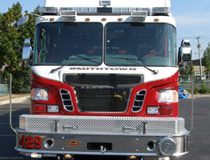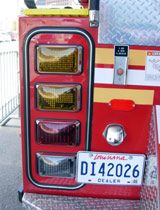 All photos Bob Vaccaro Front of heavy rescue showing upper level LED light bar facing forward and two small bars facing sideways. There are white and red strobe lights, two brow lights for forward scene lighting and below the bumper lighting for ground lighting. |
Have you ever been in your vehicle or walking along the street, seen a fire truck pass you by and been struck by all of that great emergency lighting on it?
It seems that in the past, we saw vehicles loaded with a mixture of strobe lights and the old style revolving lights. I say old style, because it seems that LED lights have taken the industry by storm and are improving rapidly.
While it may be possible for overkill when you spec out a vehicle’s emergency lighting, you can’t buy it without NFPA standards becoming involved. If you look at the NFPA bible on apparatus, NFPA 1901, you should check out Chapter 13: Low Voltage Electrical Systems and Warning Devices.
This section spells out all of the do’s and don’ts of lighting your vehicles. It includes types of batteries, wiring, power supplies, load management and optical warning devices for upper level, midmount and lower level mounting — it is all there in black and white.
Just about every area of the apparatus is covered. Some areas particularly worth highlighting are:
Ground Lighting
13.10.1.1: The work area immediately behind the vehicle shall be illuminated to a level of at least 3 fc (foot candles) within a 10 ft x10 ft square to the rear of the vehicle.
13.10.1.2: The fire apparatus shall be equipped with lighting that is capable of providing illumination at a minimum level of 1 fc on ground areas designated for personnel to climb onto apparatus or descend from the apparatus to the ground level.
13.10.1.3: Lighting designed to provide illumination on areas under the driver and crew riding areas shall be switch able but activated automatically when the exit doors are open.
 Lower level LED light cluster. |
These are just a few examples. Other areas covered are hose bed lighting, compartment lighting, hazard lights, stop, tail and directional lights, and interior lighting.
One part of the 1901 standard that should also be read is Annex A. This explains in detail and with diagrams how and where lighting should be placed, as well as some operational guidelines:
A.13.8.7.3: Under typical conditions, the specified optical warning system provides effective balanced warning. In some situations, however, the safety of the apparatus can be increased by turning off some warning devices. For example, if other vehicles need to pass in close proximity to the parked apparatus, the possibility of distracting other drivers can be reduced if the headlights and lower level warning lights are turned off. When responding in snow or fog, it could be desirable to turn off forward facing strobes or oscillating lights to reduce visual disorientation of the apparatus driver.
A.13..8.12: Flashing headlights are used in many areas as warning lights and provide and inexpensive way to obtain additional warning to the front of the apparatus. Daylight flashing of the high beam filaments is very effective and is generally considered safe. Nighttime flashing could affect the vision of oncoming drivers as well as make driving that apparatus more difficult.
In some areas, headlight flashing is prohibited or limited to certain types of vehicles. If flashing headlights are employed on fire apparatus, they are to be turned off when the apparatus headlights are on. They should be also turned off, along with all other white warning lights when the apparatus is in the blocking mode.
 Combination strobe and LED lighting on the front of this vehicle. |
Steady burning headlights are not considered warning lights and can be illuminated in the blocking mode to light the area in front of the vehicle. Consideration should be given, however, to avoid shining lights into the eyes of oncoming drivers.
These two examples are only a few that are listed. This area of the standard makes for an interesting read if you are specing out a vehicle and need to obtain some excellent information about how to go about lighting your vehicles and what is required.
Your apparatus manufacturer’s engineer and sales rep are also excellent resources when you begin the process of building your apparatus.
And you thought all that lighting was for show!











